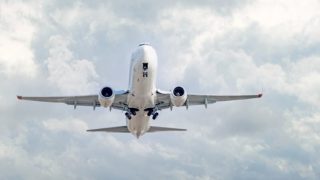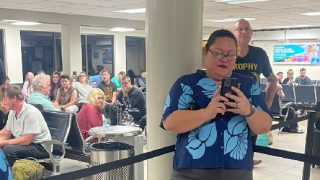Amidst the twinkling lights and festive spirit of Christmas, Hawaii’s skies recently witnessed a strange and unique twist – two pre-Christmas flight diversions on the same route and day that added a touch of holiday mystery to the usually serene holiday atmosphere.
These two weekend Hawaii flight diversions caught our attention for multiple reasons. It has been a number of weeks since the last spate of Hawaii flight diversions, suggesting a period of relative quiet in that regard. However, yesterday, in the lead-up to Christmas, not one but two mid-air flight diversions occurred with two airlines on the same route departing the same Hawaii airport for the same mainland destination. And they both ended up with a nearly identical diversion path that ended in exactly the same place.


Southwest Airlines Flight 1357 Hawaii flight diversion.
Saturday morning, the flight departed Kona three minutes early at 9:47 am. It was bound for San Jose. But instead of landing on the mainland, some two hours and five minutes later, at 11:42 am, the flight diverted to Honolulu. The reason for the diversion remains unclear of the 1.5 year old Boeing 737 MAX 8.
It remained on the ground in Honolulu, and the flight did not continue. Instead, another 1.5 year old Boeing 737 MAX 8 was summoned, which then took off at 2:22 pm and landed in San Jose at 9:19 pm Saturday night.
Given that the aircraft that continued the flight was not the same one, it would appear the diversion may have been for mechanical reasons associated with the plane.


Alaska Airlines Flight 956 Hawaii flight diversion.
The Alaska Airlines flight, on the same route as the Southwest flight that diverted a couple of hours earlier, departed Kona six minutes early at 12:54 pm. It got somewhat further than the Southwest flight. But it also ended up diverting and returned to Hawaii’s Honolulu Airport at 3:28 pm yesterday. A continuation of the same flight on the same aircraft was scheduled for later Saturday. That flight, however, appears to have been subsequently canceled. The same plane, using a different flight number, is continuing yesterday’s flight and is in route today. It departed Honolulu at 9:19 am and is due in San Jose at 3:53 pm.
The cause of the diversions isn’t known at this time.
We suspect that whatever it was, there might have also been a crew timeout issue that resulted in an overnight delay before it continued to the mainland. But that, too, isn’t certain.
Hawaii flight diversions, like the ones experienced yesterday by both Southwest Airlines and Alaska Airlines, can stem from various factors, including medical emergencies involving passengers or crew, adverse weather conditions, disruptive incidents, and, of course, mechanical problems.
We also checked solar flares, and it has been reported that solar activity is relatively low at present. There has been ongoing speculation about solar flares potentially being a contributory factor in mechanical flight diversions.
Flight transiting the world’s longest expanse of ocean without designated diversion points.
It is important to note that flights bound to and from Hawaii adhere to stringent ETOPS regulations, specifically addressing potential mechanical issues. These regulations are there due to the unique overwater nature of the routes. In the case of Hawaii, these involve crossing the world’s longest expanse of ocean without designated diversion points.
No fewer than five Hawaii flight diversion incidents occurred in one month.
Lightning struck a Hawaiian Airlines plane in October, resulting in a mid-air diversion. In that event on October 1, Hawaiian Airlines Flight 5, en route from Las Vegas to Honolulu, experienced a 90-minute delay before takeoff. Shortly after departure, the A330-200 widebody jetliner was reportedly struck by lightning, prompting a swift return to Las Vegas, landing just 21 minutes after takeoff.
Hawaiian confirmed the lightning strike, indicating that there were 289 passengers and crew members on board the flight. Following mandatory aircraft inspections, the flight resumed its journey, with passengers having been accommodated with meals and lodging. Lightning strikes during flights are rare, and airlines implement precautions to avoid adverse weather, with safety measures in place to handle lightning strikes if they occur.
Two dozen Hawaii flight diversions in recent months.
There were four additional Hawaii flight diversions in October, including two on United Airlines. Those, together with the two reported today, brought the total of recent Hawaii flight diversions to two dozen or more in just the past few months.
The Christmas magic on the ground was obfuscated with events in the air that created what is undoubtedly a unique chapter in the stories of those who traversed the Pacific skies yesterday on these flights, during this joyful season. Were you on one of these flights? If so, please help us with further details.
Kudos to the airlines for bringing these events to a safe conclusion. Hat tip to Steven C.
Get Breaking Hawaii Travel News







On December 23rd Alaska flight 810 from Lihue to Seattle also diverted to Honolulu.
“…But instead of landing on the mainland, some two hours and five minutes later,” Two hours and 5 minutes later? That’s some quick flight from Hawaii to the mainland. 😉
Merry Christmas.
Hi Patrick.
Lol. Thanks and a Happy New Year of travels to you!
Aloha.
IMO, with 40+ years in USN and commercial flying in the Pacific – and based in Honolulu on the 747 for 15+ years – you are reading too much into these recent events. They happen and they’ve happened for decades. But the “media” and the traveling public – folks who are guessing at events without an understanding of the demands of commercial aviation – are paying more attention to “it” these days. Once again, just my opinion.
I would suggest they’re due to an overall lowering of standards in the industry – i.e., hiring criteria, pilot experience, technical/mechanic personnel experience, parts supplies on hand — the whole gamut of operational things that keep airplanes in the air.
And the reason?? It’s $$$$$ – believe it.
Santa trying out a new sled?
Question, at what point during the flight is it determined to return to Hawaii? If it’s halfway do they continue to the mainland somewhere instead of returning to Hawaii?
Hi John.
Generally speaking, that is correct.
Aloha.
It depends upon the circumstances — as always in aviation — such as the “Why” in “do we need to abort the flight while airborne/enroute” – as sometimes it’s determined by ground facilities or maintenance services available in addition to the reason for considering a return to the flight origin point, but generally speaking:
The Point of no Return (PNR) is the furthest distance an aircraft can travel from it’s departure point and return to this same departure point with the consumption of all usable fuel except fuel reserves (a.k.a. ‘Safe Endurance’).
The biggest question in my mind is to what extent safety, security and consumer needs issues and expectations being met or not met? What weak spots are developing and what are the causes… climate change? dysfunctional governance? What is the broader issue of climate change revealing about it’s role in disrupting airline travel? I’d like to read more on these issues.
Thanks.